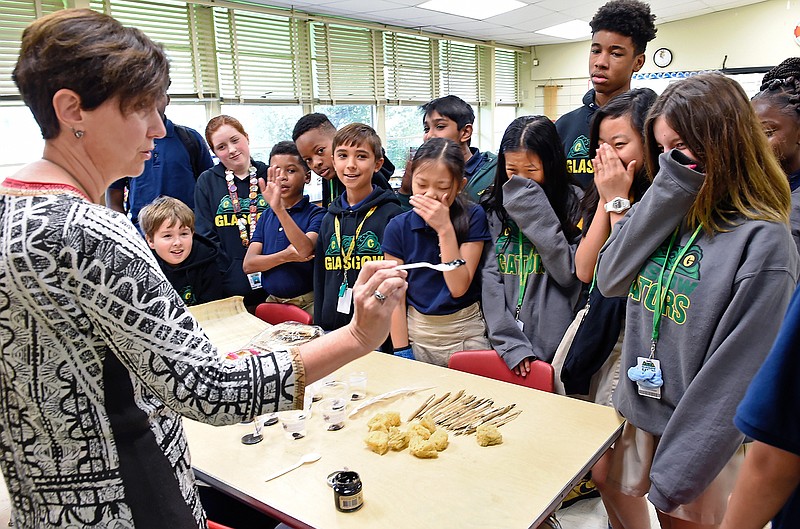BATON ROUGE, La. - Nathalie Roy has fused her passion for Latin with her interest in the wonders of the ancient world. The result is something new: a class in Roman Technology.
This unlikely elective course open to students at Glasgow Middle School in Baton Rouge connects traditional, classical studies with STEM - short for science, technology, engineering and math. Albeit it is STEM as it existed many centuries ago.
On a recent Friday, Roy had her students at Glasgow do a writing assignment. One of ancient vintage. Smelly too.
Gathering everyone in a semicircle, she grabbed a plastic spoon, scooped up some black inky stuff and held it out for the middle schoolers to sniff one by one.
"It has a very strong odor," Roy said. "It smells like fish."
It did, powerfully, unsurprisingly so since it came from a fish. Cuttlefish to be precise, which is in the squid family. Roy then handed each student a small jar of this squid ink, along with a small wooden stick meant to mimic a Roman reed pen and a sheet of papyrus to write on.
The career Latin teacher devised this class a few years ago. She also teaches classes in Latin and classical mythology.
Roy described the origins of her Roman Technology class and how it has developed in a paper published earlier this year in The Classical Outlook, which she described as the leading publication for classroom humanities teachers.
The course originated at a time when Episcopal increased its emphasis on STEM instruction. With help from an administrator focused on science instruction, she developed the new elective course.
Part of the inspiration came from a PBS show she's watched for years, "Nova - Secrets of Lost Empires."
She recalls in her essay an episode in which PBS sought to recreate the sail cloth roof that once covered the Colosseum in Rome. So they hired a structural engineer, a Roman historian, a "big top circus tent owner" and a sailor who then did just that.
"I didn't have a Nova budget or the expertise of an engineer," she wrote. "My class projects would have to be smaller in scale, and I would have to do a lot of independent research since I would not have the money to hire professional experts."
She would lecture less and do more, recreating "Roman products and processes using the methods and concepts of experimental archaeology."
Through her research, she amassed a broad set of interactive lessons: spinning and hair styling; mixing and setting concrete; record-keeping with wax tablets, papyrus, and abaci; making hydraulic devices, such as aqueducts and water screws; and forging such weapons as catapults and shields.
"Students like to do and create things," Roy wrote. "The best days of class were those spent hammering, pouring, mixing, tasting, fixing and actively experimenting."
Though she's just starting her second year, Roy has already made a mark at Glasgow. She quickly earned a classroom grant from ExxonMobil. She documents her classroom exploits on her professional Twitter page, @MagistraRoy. And she's presented at conferences. Cambridge University Press recently published a blog post of hers. Now she's developing a second academic paper for another classical academic journal.
The courtyard at Glasgow Middle has a can't-miss-it reminder of her work. There is a classical sundial, with a mosaic carved on each stone, that her students built last year. This year, they plan to build a kiln to use to bake pottery.
The papyrus lesson is comparatively small in scope, but is nonetheless instructive.
After handing them their supplies, Roy asked write something on the papyrus that meant something to them.
Several wrote song lyrics. At least one girl wrote something in Latin.
Roy pointed out that papyrus originated in Egypt, not with the Romans.
"The Romans were very good at taking other people's technology and either improving it or really changing it for their own purposes," she said.
Mindful of the origins of papyrus, Megan Guo, 11, pulled out a book with examples of Egyptian hieroglyphics for what she wrote. She had a cast on her left wrist but that didn't seem to slow her down. The pen and squid ink, however, proved more difficult to use than a fountain pen and paper.
"It's kind of the same but it's a little harder, because you have to keep on dipping," Guo said.
"After every letter you have to dip," added Mary Avery 'MA" Rodrigue, 12, who was sitting next to her.
To show how papyrus leaves traces of past writing, forming what's known as a palimpsest, Roy gave each real sponges, from the sea, to erase portions of what they were writing.
"You got to erase some part of it, just to try it," she told the class. "If you don't want to erase what you wrote, then write a little thing on the side and try erasing that."
As they students finished, Roy collected their papyrus sheets, and the students washed their smelly hands. Before the final bell, Roy gave them one last thing to reflect upon.
"I also want you to consider who would have been using this," she said.
While affluent Romans would sometimes do their own writing, most often they employed a secretary, who also happened to be a slave, she said.
"Imagine trying to write with that kind of ink all day long," Roy said. "The smell would probably get into your nostrils and you probably wouldn't be able to get rid of it. It would be with you all the time."


